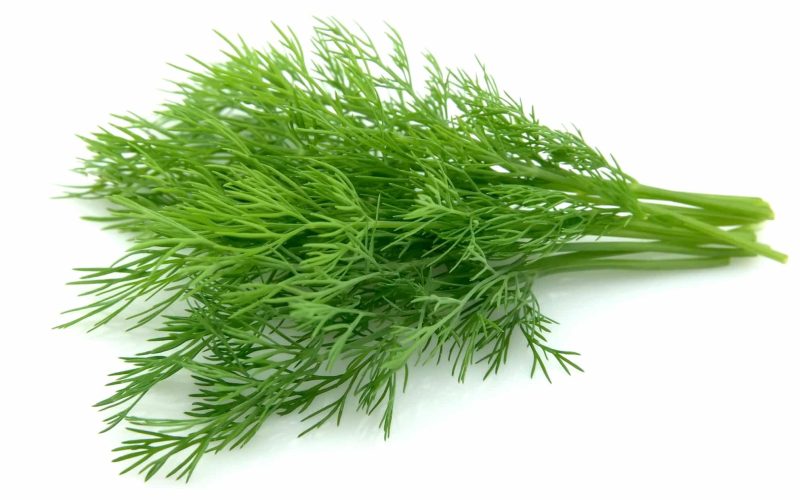The delightful herb dill can be used in various cuisines, and there are also numerous best substitutes for dill.
The health advantages we receive from dill are somewhat restricted because it is often consumed in tiny amounts.
Dill, however, has a wide range of vitamins and minerals. It has traditionally been used in Ayurvedic medicine to treat digestive issues, newborn colic, and halitosis (poor breath).
Studies have also suggested that dill may help lower blood sugar levels, which may help manage diabetes.
But there are many alternatives you may use if you don’t have any dill on hand or don’t want to use it all. Here are some of the top best substitutes for dill.
1. Chervil
Chervil, a plant related to parsley and the first on our list of the best substitutes for dill, is frequently used in French cooking.
Chervil is paler and has frillier leaves than flat-leaf parsley. Its milder flavor is comparable to both licorice and anise.
Some people compare the flavor to a combination of parsley and tarragon.
Chervil, tarragon, and parsley are the three herbs that are frequently used interchangeably.
Chervil is most frequently used in salads and soups since it is less likely to be overpowering in these dishes. It is also considered a delectable fish, chicken, and egg seasoning.
One of its more well-known applications is as a key component of the French concoction known as “fines herbs,” which also contains tarragon, parsley, and chives.
Additionally, sauces, rubs, and garnishes frequently employ it. Due to its taste, Chervil is frequently used in light sauces and herb butter.
Chervil is frequently used in light sauces and herb butter since the other ingredients won’t dominate its flavor.
Whether fresh or dried, Chervil can be used as a rub to give chicken, fish, or potatoes a spring flavor.
Because chervil is less widespread than other herbs or spices, it can occasionally be challenging to find.
Thought of as a spring herb, it becomes extremely bitter once it flowers. Use as soon as the flavor is still stable.
2. Rosemary
Rosemary is a typical seasoning used in food for hundreds of years. In contrast to the other herbs on this list of best substitutes for dill, rosemary grows as a bush or shrub that resembles an evergreen tree.
It is a helpful plant for those who suffer from problems with their memory, stomach, or circulation problems.
This herb tastes and smells significantly differently from other flavoring herbs.
Rosemary is astringent and unrelated to dill weed. It doesn’t have the same flavor as dill and will undoubtedly alter any recipe you use it in.
But that doesn’t mean that recipes with dill weed also work well with rosemary.
Including rosemary will give your cuisine a distinctive flavor even though it won’t produce a similar taste or texture.
Whether or not it would make a dish better depends on personal preference, but it offers an interesting contrast to other, gentler spices.
A common sauce for steaks or potatoes is rosemary and garlic butter. This mixture enhances the dish without dominating the butter’s flavor.
Additionally, lamb, hog, poultry, and game meats are frequently prepared with rosemary.
Rosemary seasoning enhances the flavor of various vegetables, including spinach, potatoes, onions, mushrooms, fish, and grains. It is also one of the best substitutes for dill. You should give it a try!
3. Tarragon
The most popular and best substitutes for dill in cooking and meal preparation include this herb.
While tarragon loses some flavor intensity when heated, like dill weed, its scent can be overpowering.
Historically a mainstay of French cuisine, tarragon has only recently gained popularity in other cuisines.
Although less potent, it has a flavor that is similar to licorice. The taste of tarragon differs from other licorice-flavored plants like fennel due to its softer appearance and hints of other flavors.
Overall, it’s a very delicate herb that gives food subtle nuances.
Fresh tarragon is frequently a main ingredient in sauces, especially the French Bearnaise sauce. Typically, tarragon herbs are used in foods like chicken, eggs, or fish.
Although it doesn’t have quite the same level of flavor as a fresh sprig, dried tarragon can also be used as a spice.
A French spice mixture containing chives, chervil, and parsley includes tarragon. This mixture is a common seasoning in more well-known French meals and cuisine.
4. Parsley
Except for the leaves, parsley and dill look pretty alike. Parsley leaves are soft and leafy, but dill leaves are thin and prickly.
Parsley is a simple substitute for dillweed, giving your food a new flavor and texture.
Among the numerous best substitutes for dill, Parsley is frequently used as a garnish instead of salt.
It provides soups or dinners with a light and somewhat spicy flavor. It is perfect for various cuisines because it may enhance any flavor profile.
Parsley improves the flavor of the main meal and the other ingredients when combined with other herbs.
One of the most common dill weed substitutes is parsley, which sometimes pairs well with dill to create a distinctive and pleasant flavor. Either flat-leaf or curly-leaf parsley is available fresh.
Flat-leaf parsley is more frequently used in cooking because some think it has a stronger flavor than curly-leaf.
Typically used as a garnish because it offers the additional texture of curly leaf parsley. Both root parsley and dried parsley have their uses in cookery.
Root parsley is raised as a root vegetable and used in soups and stews because its roots are thicker.
5. Basil
Basil, a member of the mint family and one of the herbs on this list with a sweet flavor, is frequently used in Italian and Vietnamese cuisine.
The flavor varies slightly depending on the variety you purchase. For instance, Thai basil can be used instead of dillweed because it is savory and has licorice undertones.
Fresh basil will lose flavor when added to a heated mixture of ingredients, just like dill and tarragon do.
The best ways to use both types of basil are to add fresh basil just before serving and dried basil first.
One of the essential components in pesto is basil, one of the best substitutes for dill.
It is frequently served with tomatoes to reduce acidity and offer a more balanced flavor. Additionally, basil can be used as a garnish on foods like pizza.
Although sweet basil is frequently used in cooking, other variants produce distinct culinary outcomes.
There are distinct smells and scents associated with Thai basil, lemon basil, spicy bush basil, and cinnamon basil.
Most of the varieties on the list have names that indicate the flavor they offer.
But more than 60 different types of basil may give your meal a distinctive flavor profile.
6. Thyme
Of the best substitutes for dill, thyme is the following option for Dill seeds. The mint family includes herbs like fresh thyme, which has a strong flavor.
Thyme works nicely while preparing pasta sauces, soups, stews, and eggplant in addition to those foods.
Thyme has a stronger aroma than dill weed, which is relatively weak. Even after baking or other cooking processes, it might retain its taste.
This makes them great for tomato soups, roasted potatoes, and vegetable salads.
Conclusion
It can be challenging to find the suitable and best substitutes for dill because no other herb comes close to having the same flavor.
However, many options are available if you require a different spice to replace dill.
The wonderful features of tarragon, parsley, basil, chervil, and rosemary make them all fascinating and delicious flavors for cuisine.
You can use tarragon, chervil, or parsley as a substitute for dill for a more accurate recreation that allows for softer flavors.
Depending on the variety you select, basil might give your food a subtle yet distinctive flavor.
Or, for a new experience that can alter the flavor and consistency of your entire dinner, you might add rosemary.
Whatever you choose as a replacement won’t be the same. But each of these herbs offers a distinctive flavor that works in particular ways to enhance your dish.
Any aromatic herb can be used in its stead if you don’t have any dillweed for your recipe.
It won’t have the same taste or impact, but it will still spice up your meals in various ways.








